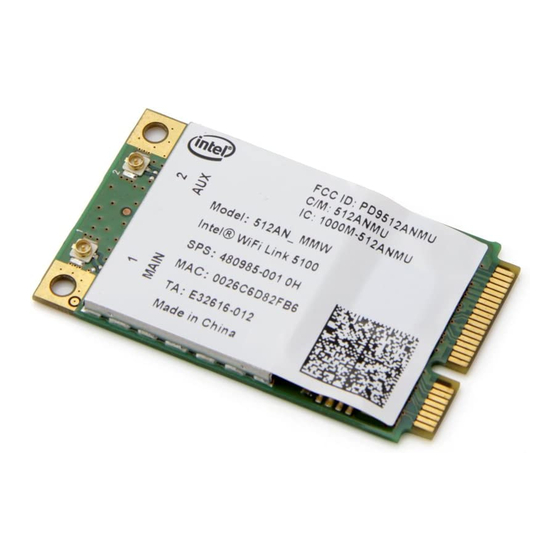
Table of Contents
Advertisement
Intel® PROSet/Wireless WiFi Connection Utility User's Guide
Supported wireless adapters:
Intel® Centrino® Ultimate-N 6300
Intel® Centrino® Advanced-N + WiMAX 6250
Intel® Centrino® Advanced-N 6200
Intel® Centrino® Wireless-N 1000
Intel® WiMAX/WiFi Link 5350
Intel® WiFi Link 5300
Intel® WiMAX/WiFi Link 5150
Intel® WiFi Link 5100
Intel® Wireless WiFi Link 4965AGN
Intel® Wireless WiFi Link 4965AG_
Intel® PRO/Wireless 3945ABG Network Connection
Intel® PRO/Wireless 3945_BG Network Connection
With your WiFi network card, you can access WiFi networks, share files or printers, or even share your Internet
connection. All of these features can be explored using a WiFi network in your home or office. This WiFi network
solution is designed for both home and business use. Additional users and features can be added as your
networking needs grow and change.
Depending on the model of your Intel WiFi adapter, your adapter is compatible with 802.11a, 802.11b, 802.11g,
and 802.11n (draft 2.0) wireless standards. Operating at 5 GHz or 2.4 GHz frequency at data rates of up to 450
Mbps, you can now connect your computer to existing high-speed networks that use multiple access points within
large or small environments. Your WiFi adapter maintains automatic data rate control according to the access point
location and signal strength to achieve the fastest possible connection. All of your wireless network connections
are easily managed by the WiFi connection utility. Profiles that are set up through the WiFi connection utility
provide enhanced security measures with 802.1X network authentication.
Table of Contents
Use the Intel® PROSet/Wireless WiFi Connection Utility
Connect to a Network
Use Wi-Fi Protected Setup*
Use Profiles
Set up Security
WiFi Network Overview
Administrator Tool
Create Administrator Packages
Create Profiles
Security Overview
Safety and Regulatory Information
Specifications
Troubleshooting
Glossary
Customer Support
Warranty
Information in this document is subject to change without notice.
© 2004–2009 Intel Corporation. All rights reserved. Intel Corporation, 5200 N.E. Elam Young Parkway,
Hillsboro, OR 97124-6497 USA
The copying or reproducing of any material in this document in any manner whatsoever without the written
permission of Intel Corporation is strictly forbidden. Intel® is a trademark or registered trademark of Intel
Corporation or its subsidiaries in the United States and other countries. Other trademarks and trade names may
Intel® PROSet/Wireless WiFi Connection Utility User's Guide
Advertisement
Table of Contents










Need help?
Do you have a question about the 512AN_MMW and is the answer not in the manual?
Questions and answers